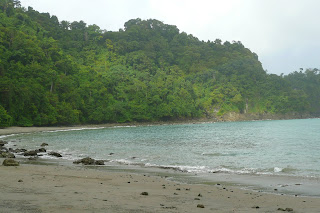
I was feeling John Muir-ish. To know what that means you ought to know that all I know about John Muir is that he was a Scottish naturalist who spent a lot of time in the Pacific Northwest advocating for protected land, laying on rocks to figure out how glaciers moved and getting up into pine trees during storm to feel the sway of them and figure something out with that.
It’s the later part that’s important to how I was feeling John Muir-ish in
After struggling against the waves and riptides, I retreated to the shore, letting the rain pelt my upturned face and body. It pooled in the sand around me. I had to get up when a group of tourists on a soggy sunset beach ride passed. I didn’t want to be trod upon.
I hadn’t had my fill of John Muir-ish-ness though, so I lay on the sand at the water’s edge letting the waves crash and push me higher up the strand, of pull me into the water. It was hard not to cheat and help the pull since I looked stupid lying limbs awry, sand covered, on the beach. Also, the larger waves got sand in my mouth and eyes—hair and ears too though that was less bothersome—and the sand was getting uncomfortable generally.
So, still not Muir-ed out, and definitely not satisfied with how these experiments were going, I gave the pull some more help by crab-walking* into the surf, turning over, and going limp except to hold my nose—also don’t like sand going there. I would float as long as I could hold my breath, face down in the water until I came up for gulps of air and then back down. Where would the tide take me? The experiment was on.
I could of course tell when it pushed me out and pulled me back. It seemed to keep me about 20 feet from shore in1-3 foot deep water. My toes, knees, hands, elbows, and knuckles dragged and traced arcs in the water. Eyes closed and face down, I couldn’t tell how much turning of my body the arcs indicated. I couldn’t tell what pattern my body was tracing in the churned up and soaked sand.

To solve the problem, I imagined attaching imaging devices to my various joints in order to trace their movement with a computer which I could then render as an image later. The lines would be color coded and I could make it so you could see all the various lines traced, or isolate one for closer scrutiny. In imagining this, my only reference was behind-the-scenes looks at video games and cgi action films and it seems that you needed a blue screen or some flat color behind the cameras, so I’d need to lay that over the sand too. It seemed a bit impractical when I thought I of asking my friends. I’d ask them when I was done John Muir-ing as driftwood. Surely they were paying attention and fascinated by this human performance of driftwood and sea.
Later, when I finally finished, I asked them “Did you see how I was moving in the turf?”
“Yeah, back and forth.”
They were not helpful. They were not in a John Muir mood.
At one time I think I turned around even though my lighter, upper body was usually towards land and my heavier, lower end pointed out to the deep blue. Other than that, my ability to learn something of just how drift wood is acted on by the sea is still a dark, hazy lurching to and fro. And maybe that’s what I already knew, but now I’ve experienced it. Oh, I also learned that it takes a lot of patience to really learn how these processes work, because most of the time, it’s just the same old stuff with tiny variations building into something unseen.
It occurred to me later that I could have just had one of my friends go dead-float for a while and I could have observed them. But I was far too gone in my imaginations of fusing with nature and ferreting out her secrets. I wanted to experience, but I also wanted to understand and analyze what was happening. Not just experience what it was like to be part of the swell and release of the ocean, but to gain some understanding about nature’s secret methods. That’s what I am really after, but that’s not something nature readily gives up. So, for now, I’ll have to be content with being blown by wind, spattered by rain, and rocked gently to and fro in the cradle of her arms.
*editor’s note: The author, if given the chance to create a mythology, would pick the crab as the god of the wind. The crabs seen in


